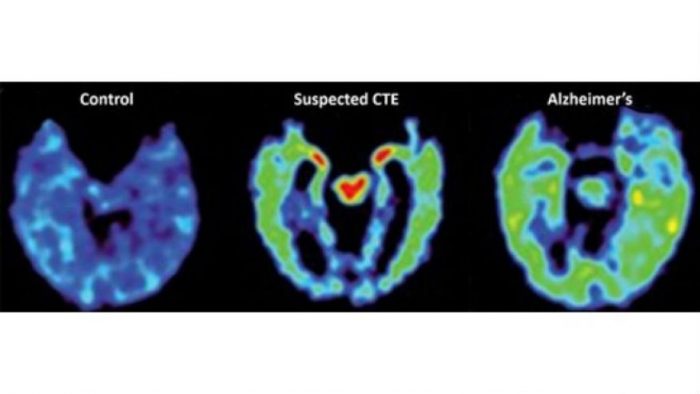
The degenerative brain disease CTE continues to haunt the NFL with a new study that shows 99 percent of former NFL players were diagnosed with the condition. In a study done at Boston University, 110 of the 111 brain donors who played in the NFL were diagnosed posthumously with CTE.
The NFL released a statement, thanking pathologist Dr. Ann McKee for her research.
“Case studies such as those compiled in this updated paper are important to further advancing the science and progress related to head trauma,” the NFL stated. “The medical and scientific communities will benefit from this publication and the NFL will continue to work with a wide range of experts to improve the health of current and former NFL athletes.”
The study tested 202 brains of American football players in total; 177 players were diagnosed with the disease. CTE was also found in three out of 14 high school players, 48 out of 53 college players, and nine of 14 semi-professional players. Canadian League players’ brains were also included; seven out of eight were diagnosed with CTE.

CTE, short for Chronic Traumatic Encephalopathy, can develop in the brain after one suffers multiple head traumas and concussions.
When a person experiences a head trauma, the brain releases tau proteins. Buildup of the tau protein can cause symptoms like depression, aggression, confusion, suicidal thoughts, and memory loss.

Pittsburgh Steeler quarterback Ben Roethlisberger recently noted how the CTE study would determine his retirement plans. However, news of the study did not faze Jets rookie safety Jamal Adams and six-year cornerback Morris Claiborne, mentioning how they “would die” on the football field. Claiborne endured three documented concussions in the past 10 years.
A brain can be donated to research as long as the person has experienced head trauma. Family members usually consider donating when their loved one experiences symptoms similar to the effects of tau-protein build up.

CTE and head trauma in football has been a discussion for years, the NFL is often ridiculed for doing little to discover a cure. In the 1990’s, the League created the Mild Traumatic Brain Injury (MTBI) Committee; in 1999, the MTBI declared “brain injuries in football are rare.”
History changed when Bennet I. Omalu M.D. and Julian Bailes M.D. diagnosed CTE in a pro football player for the first time. As the years progressed, the NFL and the MTBI looked for ways to disprove theories indicating that serious head injuries can cause lasting effects on football players.
Meanwhile, Omalu diagnosed CTE on several late athletes. In 2009, the NFL met with Dr. Ann McKee, who created the Center for the Study of Traumatic Encephalopathy at Boston University with Dr. Chris Nowinski. McKee noted how the league was unconcerned about her research.

At the time, the NFL funded a dementia study and learned that NFL players were 19 times more likely to have dementia and Alzheimer’s than people who don’t play football. In 2011, over 4000 NFL players sued the NFL for their effort to suppress the hazards of head injuries.
The league tried to settle out of court for $765 million but the offer was rejected and raised to $1 billion. The NFL furthered their preventive efforts in brain injures with the Heads Up Football program in 2012. The initiative taught youth proper playing techniques while focusing on ways to curtail the number of head traumas.
The majority of CTE contributors were NFL players from the 1950’s through 1990’s, before protocol was implemented to protect players from brain injuries. In 2016, the NFL pledged $100 million to provision engineering and medical innovations in the field of neuroscience.







